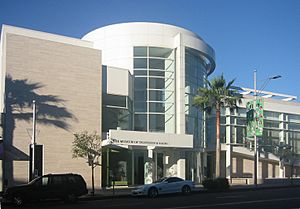Paley Center for Media facts for kids

The Paley Center for Media entrance
|
|
| Former name |
|
|---|---|
| Established | 1975 |
| Location | 25 West 52 Street, Midtown Manhattan, New York City |
| Type | Media Museum |
| Founder | William S. Paley |
The Paley Center for Media is a special place in New York City and Los Angeles. It was started in 1975 by William S. Paley. This center is all about understanding how television, radio, and new digital media like the internet and podcasts affect our culture and society.
It used to be called the Museum of Television & Radio. In 2007, its name changed to the Paley Center for Media. This new name shows that it now includes newer technologies like the Internet and podcasting. It also helps media experts talk about how media is always changing.
Contents
Where to Find the Paley Center
New York City Location
The first Museum of Broadcasting opened in New York City in 1976. It was located on 1 East 53rd Street in Manhattan. William S. Paley helped start it with a generous gift.
Los Angeles Location
In 1996, a second location opened in Beverly Hills, Los Angeles. This building was designed by a famous architect named Richard Meier.
The Beverly Hills museum closed in early 2020. Its huge collection of shows was moved to the Beverly Hills Public Library. The new archive officially opened in March 2025.
Amazing Media Archives
The Paley Center believes that many TV and radio shows are important works of art. They should be saved for the future. Instead of collecting old objects, the Paley Center has many screening rooms. These include two large theaters.
What's in the Collection?
The Paley Center's library holds nearly 160,000 television shows, commercials, and radio programs. When you visit, you can pick and watch shows at your own viewing station. You can also listen to radio programs there.
Some TV shows in the collection are from the 1940s. Radio programs go back even further, to the 1920s. The oldest TV program they have is a silent film from 1939. It's a play called The Streets of New York.
How the Archives Work
The museum does not sell any of its materials. You can only watch or listen to them at the center. Copies of the TV programs are on special video tapes. The original recordings are kept safe in a vault outside New York City. The entire collection is being turned into digital files.
The Paley Center has found many "lost" episodes of classic TV shows. They also make documentaries about the history of TV and radio. They even host special viewings of new TV show pilot episodes before they air.
New shows are added to the collection when they are discovered or donated. For example, in 2002, the museum showed a rehearsal film of Cinderella from 1957. This film was found in the CBS vault while the museum was looking for other Cinderella materials.
The center is also famous for finding many old daytime game show episodes. Shows that were thought to be lost, like High Rollers and Celebrity Sweepstakes, can now be watched in the library. Other popular game shows like Tattletales and Let's Make a Deal are also available.
Programs and Learning Events
The Paley Center often holds special talks and interviews with famous people. These events are recorded. You can watch them later at the center's viewing stations.
Famous Guests and Shows
Many well-known people have participated in these talks. These include actors like Lucille Ball and Dick Van Dyke. Writers and directors have also shared their stories.
The center also hosts talks with the creators and actors from popular TV shows. Some of these shows include Seinfeld, The Simpsons, South Park, and The Daily Show with Jon Stewart. These discussions cover what it was like to make these shows.
PaleyFest: A TV Celebration
The William S. Paley Television Festival, also known as PaleyFest, is a big annual event. It takes place in Los Angeles. Started in 1984, this festival brings together the casts and creative teams from popular TV shows.
At PaleyFest, there are panel discussions where the audience can ask questions. Shows like Community, Parks and Recreation, and Mad Men have been featured. The festival has been held in many different venues over the years. Since 2014, it has been at the Dolby Theatre in Hollywood. A similar event, PaleyFest New York, started in 2013.
See also
 In Spanish: Paley Center for Media para niños
In Spanish: Paley Center for Media para niños
- List of museums and cultural institutions in New York City
- List of old-time radio people
- List of old-time radio programs
- List of U.S. radio programs
- Museum of Broadcast Communications
- Pavek Museum of Broadcasting



